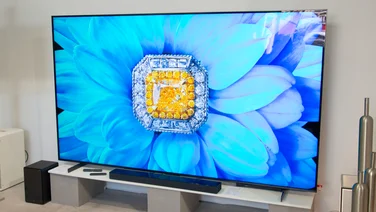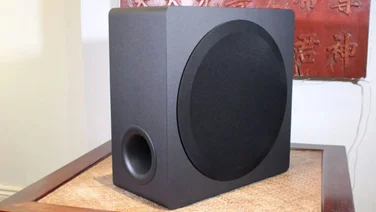To help us provide you with free impartial advice, we may earn a commission if you buy through links on our site. Learn more











- Dedicated up-firing drivers
- Compact form factor
- Decent EQ options
- Lacks low-end impact
- Inconsistent volume levels
- Unintuitive LED display
The Sharp HT-SB700 is a rarity in the world of cheap soundbars. Not only does it support Dolby Atmos but it also incorporates dedicated up-firing drivers to help bolster the height effects required to deliver the object-based audio format convincingly.
It’s the first budget soundbar I’ve tested to house such drivers and I was pleasantly surprised by the verticality they added to proceedings. It’s nicely designed and commendably compact too, and its various EQ presets cater for a decent range of use cases.
However, the absence of a subwoofer leaves it sounding lightweight when handling bass-heavy soundtracks and I was frequently frustrated when trying to find a volume level somewhere between inaudible and way too loud for general viewing.
These issues, coupled with an LED display that had me regularly reaching for the instruction manual, make it tricky to recommend, particularly given the stiff competition it faces at this price.
Sharp HT-SB700 review: What do you get for the money?
Sharp’s new 2.0.2-channel soundbar has a list price of £200, but can be purchased for £173 at the time of writing, which is around what your average punter is willing to shell out on a device to improve the sound quality of their TV. Home cinema enthusiasts will of course be happy to pay considerably more for a surround sound soundbar system with a greater number of drivers and audio channels, but the HT-SB700 wasn’t created with them in mind.











Instead, it seeks to squeeze as immersive an audio experience as possible from a soundbar that’s as petite as it is affordable. Measuring just 520 x 110 x 72mm (WDH) and weighing under 2kg, the HT-SB700 can find a home on just about any TV cabinet and is compact enough to be used in place of a pair of PC speakers on your desktop.
Housed within the HT-SB700 are two forward-firing full-range drivers handling the left and right stereo channels and up-firing drivers at each end. There’s no in-built subwoofer to look after bass reproduction, nor is there the option to connect a discrete sub. The peak output of the system is quoted at 140W.











Connectivity is basic but that’s to be expected given the HT-SB700’s price tag. There’s only one HDMI port, although to Sharp’s credit it does at least support eARC, alongside a digital optical input and a 3.5mm aux-in. You’ll also find a USB-A port located in the recess at the back of the soundbar purely for servicing. Bluetooth 5.3 allows you to stream audio from your smartphone, tablet or laptop but that’s it for wireless connectivity; the HT-SB700 can’t be hooked up to your Wi-Fi network.
Powering the bar on and off, adjusting volume, switching input and Bluetooth pairing can be handled via physical buttons located on top of the soundbar. However, you’re better off using the sensibly sized remote as it has buttons covering all of those actions plus various other features.











On the remote, you’ll find quick access buttons for the soundbar’s five EQ presets – Movie, Voice, Music, Night and 3D – along with buttons that allow you to manually adjust the bass and treble, dim the LED display and mute the soundbar. Unlike a lot of soundbars of its ilk, the Sharp HT-SB700 doesn’t have a companion app, so there’s no way to control it from your phone. There’s also no voice assistant support.
READ NEXT: Best TV deals
Sharp HT-SB700 review: What did we like about it?
The HT-SB700’s up-firing drivers quite literally elevate its performance above many similarly priced rivals; not in terms of clarity and impact, but where verticality is concerned this soundbar impresses. Even in a room with a reasonably high ceiling, I got an improved sense of height from the HT-SB700 compared with other soundbars in its price bracket. The effect was even more pronounced when I moved the bar into a more confined space.
During the first episode of season four of Apple TV+’s Slow Horses, dialogue felt like it was coming from the protagonists’ mouths rather than the bar below it and the buzz of an airborne drone sounded like it was somewhere above me rather than on a TV screen in front of me.
Support for Dolby Atmos plays a big part here but there are other immersion-enhancing options available if what you’re watching doesn’t support the format. Dolby Audio Processing, engaged by a short press of the 3D button the remote, up- or down-mixes content to optimise it for the HT-SB700’s four channels, while the Dolby Virtualiser creates surround sound using virtualisation algorithms.Given the low cost of this bar and its limited number of channels, I was surprised by how effectively these worked. They won’t transform your small living room into a home cinema but they will make you feel slightly closer to the on-screen action.
I also appreciated the bar’s EQ options. These are by no means unique to the HT-SB700 but presets for films and music and a Night mode that decreases the dynamic range for late-night viewing are always welcome. By and large, I thought the EQs suited the content types they were designed for well but, as you’ll discover in the next section, I wasn’t bowled over by the HT-SB700’s audio performance. That said, the Dialogue mode successfully boosted verbal exchanges, even in scenes with a lot of distracting background noise.
The HT-SB700 is also a very neat-looking and space-efficient soundbar. While a little taller than some of its peers, presumably to make room for the up-firing drivers, it will occupy very little space on your TV cabinet and is admirably understated.
Sharp HT-SB700 review: What could be improved?
While I generally enjoyed the HT-SB700’s output when taking advantage of its Atmos and 3D virtualisation capabilities, it has some notable shortcomings. It’s far from the last word where fine detail is concerned and its compact size results in a relatively narrow soundstage. Clarity also suffered when I pushed the volume right up, with the HT-SB700 getting a bit too shouty and succumbing to some distortion.
Its biggest weakness, however, is the absence of a satisfying low-end response. Its full-range drivers lack the thump and visceral impact of a dedicated subwoofer and sounded thin and vapid at times. You can increase bass and treble individually but I was left feeling shortchanged by explosions and musical arrangements with a strong bass component, even after boosting bass as far as it could go.











I also found it difficult to consistently achieve a comfortable listening level when using the HT-SB700. As with TV speakers, audio levels fluctuate wildly based on the source, but the increments by which you can increase the volume of the HT-SB700 don’t help matters. Its lowest level proved too quiet for almost everything I watched, while the next notch up jumped so dramatically that even relatively reserved shows like Celebrity Masterchef on iPlayer suddenly sounded overwhelming. More often than not, I found myself resorting to Night mode, which is something I typically reserve for after-hours gaming sessions.
My other issue with the HT-SB700 centres around its display, which uses single LEDs to indicate volume level, which EQ you have selected and so on. Volume level is intuitive but working out which EQ I had engaged required consultation of the manual even after a couple of weeks of use. LED displays such as this are pretty standard on budget soundbars as they’re cheap to manufacture but I’d prefer clearer visual indicators considering there’s no control app available.
Sharp HT-SB700 review: Should you buy it?
The Sharp HT-SB700’s up-firing drivers give it a unique selling point in a crowded market and make a marked difference to how well height effects are articulated by the soundbar. It’s also an ideal size for those seeking a compact Atmos-enabled audio solution to pair with a smaller television.
These qualities weren’t enough to outweigh my frustrations with other aspects of its performance, however. Bass reproduction is a key component of a gratifying movie night and fell short of the mark, finding an appropriate volume level was a constant battle, and when pushed to its limits, the HT-SB700’s audio quality sounded strained.
Your money would be better spent on the Creative Stage 360, but I’d recommend saving up an extra ton and getting the Hisense AX5125H instead. If you have the space for rear speakers and a sub, that is.






